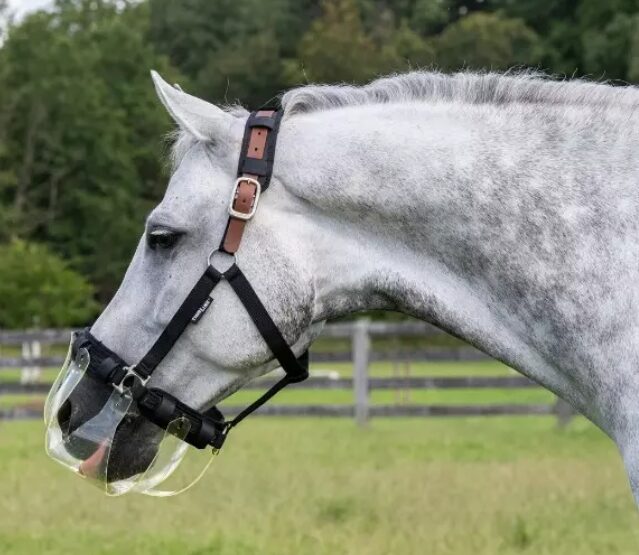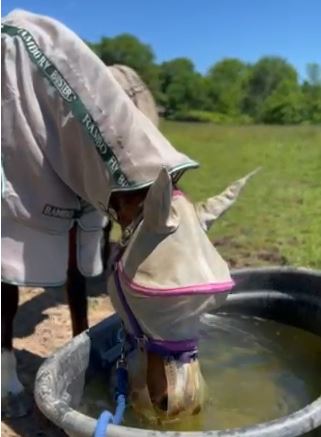Can a horse drink with a grazing muzzle? Absolutely. Surprisingly, this is a question that horse owners regularly ask.
The purpose of a grazing muzzle is to restrict a horse’s ability to graze while still allowing it to drink water freely. Grazing muzzles can reduce a horse’s forage intake from 30 – 80%, making them an extremely valuable tool in equine weight management and preventing metabolic issues.
How Grazing Muzzles Allow Horses To Drink
Most grazing muzzles attach to a halter and fit over the horse’s nose and mouth. Small openings at the bottom of the muzzle just beneath the horse’s lips limit access to grass. For many muzzles, the size of the grazing holes is standard. The grazing hole on the Flexible Filly Grazing Muzzle is customizable, so owners can adjust it if they want to.
This common opening or cutout is the main feature that allows horses to drink while wearing a grazing muzzle. Regardless of the size of the opening, when a horse dips its mouth into a bucket of water or another water source, water flows through the holes.
For this reason, clean muzzles are a must. If dirt or crud collects around the openings, it could block the free flow of water. Daily cleaning is recommended and allows you to inspect the muzzle for damage or wear and tear.
It’s essential to fit a muzzle correctly so it works properly, whether limiting your horse’s grazing or keeping him from cribbing or chewing wood.
But the correct fit is also necessary concerning drinking water. Horses suck water to drink versus dogs who lap with their tongues. Therefore, there should be only enough room between the muzzle and the horse’s lips to stick its tongue out slightly.
The muzzle shouldn’t fit too snug or too loose. Generally speaking, the space between the horse’s mouth and the inside of the muzzle should be able to fit two fingers.
Muzzles can be tricky depending upon the material they’re made of, the sensitivity of your horse’s lips, nose, and skin, and the size of the muzzle in relation to the shape of your horse’s muzzle area.
Some muzzles can be prone to rubbing the skin, creating sores, and even wearing teeth down if they fit poorly or are constructed with a rigid material. The soft, polymer material that the Flexible Filly Grazing muzzle is made of reduces the chance of skin irritation or tooth damage.

Observe How Much Water Your Horse Is Drinking
When wearing a grazing muzzle, monitoring your horse’s water intake is essential, especially at the beginning.
Horses typically drink between 25 and 70 liters (6.6 to 18 gallons) daily, with various factors like weight and weather affecting this amount. It may take time for your horse to learn how to drink while wearing a muzzle.
Every horse reacts differently, so patience is vital during the introductory phase. Some horses flat-out resent wearing a muzzle and will do everything they can to remove it. When they can’t get it off, they may become frustrated.
Some horses dislike the weight of the muzzle. When some muzzles get wet, they become heavier depending on what they’re made of, which is problematic because your horse needs to be comfortable when drinking. The Flexible Filly Grazing Muzzle’s lightweight polymer material doesn’t absorb water.
Compatibility with Automatic Waterers and Other Drinking Sources
Grazing muzzles are a way of life for horses requiring them, so compatibility with all drinking sources, including automatic watering systems, is imperative. Float, bowl, trough, and heated waterers are commonly used.
When properly fitted, grazing muzzles will not hinder a horse’s ability to drink from an automatic watering system.
The meter on an automatic waterer allows for easy monitoring of a horse’s intake, ensuring they receive sufficient hydration.

Potential Hazards
Whenever a horse or pony wears anything during turnout, the potential for injury to the animal, damage to the item, or both is present. This potential holds valid for grazing muzzles.
In most cases, the risks are relatively low if the item is well-designed, high-quality, and correctly fitted. ThinLine recognizes this reality and designed the Flexible Filly Grazing Muzzle so it’s rated to break just before your turnout halter.
As a precaution, check for gate latches, debris, sticks, large brush in the field, or broken fence lines that could cause the grazing muzzle to get caught or hooked.
Summary
Grazing muzzles are an effective solution for controlling equine forage consumption while allowing water access.
Understanding how these muzzles are designed to limit grass intake yet allow water consumption and what maintenance they require is necessary for horse owners who want their animals to stay well-hydrated and healthy. Whether your horse grazes alone or in a herd setting, using a grazing muzzle can be valuable for weight management and preventing metabolic issues.
Popular Questions
Below you can see some of the common questions were asked about this topic.
How many hours a day should a horse wear a grazing muzzle?
Many horses wear grazing muzzles for 10-12 hours or as long as they are turned out on grass.
Are there negatives or problems with using grazing muzzles?
Using grazing muzzles may inhibit a horse’s natural behavior. Incorrect-fitting muzzles can cause discomfort and abrasions on the nose and chin area of the horse and wear down teeth.
Can a horse drink with a grazing muzzle?
Grazing muzzles are designed to allow horses to drink water while reducing their grass consumption. This purpose serves as a helpful measure in preventing overeating and maintaining an ideal weight for horses who spend time grazing outdoors.
How often should a grazing muzzle be cleaned?
Regular grazing muzzle cleaning is necessary for hygiene and preventing dirt buildup. It should be wiped down with a damp cloth multiple times per week, and if it becomes noticeably dirty, it can also be sprayed thoroughly with water from a hose.
Can a grazing muzzle affect a horse’s social interactions within the herd?
While a grazing muzzle can prevent horses from engaging in mutual grooming, it still enables them to interact with their herd while turned out. The ability to interact means the horse is not completely isolated but can still socialize within the group using normal behaviors such as nuzzling and interacting through touch. The softer and more flexible grazing muzzles like the Flexible Filly often promote increased normal interaction.

